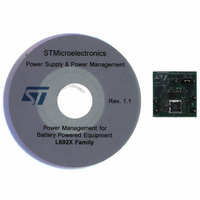EVAL6928D STMicroelectronics, EVAL6928D Datasheet - Page 9

EVAL6928D
Manufacturer Part Number
EVAL6928D
Description
BOARD EVAL L6928 STEP DOWN REG
Manufacturer
STMicroelectronics
Type
DC/DC Switching Converters, Regulators & Controllersr
Specifications of EVAL6928D
Design Resources
EVAL6928D/L6928D Gerber Files
Main Purpose
DC/DC, Step Down
Outputs And Type
1, Non-Isolated
Voltage - Output
0.6 ~ 5.5V
Current - Output
800mA
Voltage - Input
2 ~ 5.5V
Regulator Topology
Buck
Frequency - Switching
1.4MHz
Board Type
Fully Populated
Utilized Ic / Part
L6928
Input Voltage
2 V to 5.5 V
Output Voltage
0.6 V
Product
Power Management Modules
Lead Free Status / RoHS Status
Lead free / RoHS Compliant
Power - Output
-
Lead Free Status / Rohs Status
Compliant
For Use With/related Products
L6928
Other names
497-4745
Available stocks
Company
Part Number
Manufacturer
Quantity
Price
L6928
4.3
4.4
current limit, the high side MOSFET turns off and so the T
minimum value (250 ns typ.) in order to reduce as much as possible ΔI
Anyway, if V
because during the T
Due to this reason a second protection that fixes the maximum inductor valley current has
been introduced. This protection doesn't allow the high side MOSFET to turn on if the
current flowing through the inductor is higher that a specified threshold (valley current limit).
Basically the T
this threshold. So, the maximum peak current in worst case conditions will be:
Equation 3
Where I
high side MOSFET.
Slope compensation
In current mode architectures, when the duty cycle of the application is higher than
approximately 50%, a pulse-by-pulse instability (the so called sub harmonic oscillation) can
occur. To allow loop stability also in these conditions a slope compensation is present. This
is realized by reducing the current flowing through the inductor necessary to trigger the
COMP comparator (with a fixed value for the COMP pin voltage). With a given duty cycle
higher than 50%, the stability problem is particularly present with an higher input voltage
(due to the increased current ripple across the inductor), so the slope compensation effect
increases as the input voltage increases. From an application point of view, the final effect is
that the peak current limit depends both on the duty cycle (if higher than approximately 40%)
and on the input voltage.
Loop stability
Since the device is realized with a current mode architecture, the loop stability is usually not
a big issue. For most of the application a 220 pF connected between the COMP pin and
ground is enough to guarantee the stability. In case very low ESR capacitors are used for
the output filter, such as multilayer ceramic capacitors, the zero introduced by the capacitor
itself can shift at very high frequency and the transient loop response could be affected.
Adding a series resistor to the 220 pF capacitor can solve this problem.
The right value for the resistor (in the range of 50 K) can be determined by checking the load
transient response of the device. Basically, the output voltage has to be checked at the
scope after the load steps required by the application. In case of stability problems, the
output voltage could oscillates before to reach the regulated value after a load step.
PEAK
OUT
is the valley current limit (1.4 A typ.) and T
OFF
is low enough it can be that the inductor peak current further increases
is increased as much as required to bring the inductor current down to
OFF
the current decays very slowly.
Doc ID 11051 Rev 6
I
PEAK
=
I
VALLEY
+
V
-------- - T
L
IN
⋅
ON_MIN
ON_MIN
ON
is reduced down to the
is the minimum T
Operation description
ON
.
ON
of the
9/16













